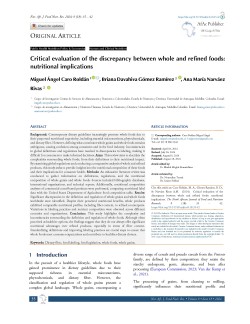Main Article Content
Critical evaluation of the discrepancy between whole and refined foods: nutritional implications
Abstract
Background: Contemporary dietary guidelines increasingly promote whole foods for their supposed nutritional richness, including essential micronutrients, phytochemicals, and dietary fiber. However, defining what constitutes whole grains and whole foods remains ambiguous, causing confusion among consumers and in the food industry. Inconsistencies in global definitions and regulations have resulted in discrepancies in labeling, making it difficult for consumers to make informed decisions.
Aims: This analysis aims to clarify the complexities surrounding whole foods, from their definitions to their nutritional impact. By examining global regulations and conducting a comparative analysis of whole and refined products, this study seeks to provide insights into the nutritional composition of these foods and their implications for consumer health.
Methods: An exhaustive literature review was conducted to gather information on definitions, regulations, and the nutritional composition of whole grains and whole foods. Sources included bibliographic databases, international organizations, and technical reports. Additionally, nutritional composition analyses of commercial cereal-based products were performed, comparing nutritional label data with the United States Department of Agriculture food composition table.
Results: The analysis revealed discrepancies in the definition and regulation of whole grains and whole foods worldwide. Despite being promoted for their nutritional value, whole products exhibited surprising similarities in nutritional content compared to refined products, particularly in fiber content. Moreover, variations in labeling practices and nutrient composition were observed across different countries and organizations.
Conclusion: This study highlights the complexity and inconsistencies surrounding the definition and regulation of whole foods. Although often perceived as healthier options, the findings suggest that they do not always offer significant nutritional advantages over refined products, especially in terms of fiber content. Standardizing definitions and improving labeling practices are crucial steps to ensure that whole foods meet consumer expectations and contribute to healthier dietary choices.
Key words: Whole Grains, Whole Foods, Dietary Fibers, Food Legislation, Food Labeling.







